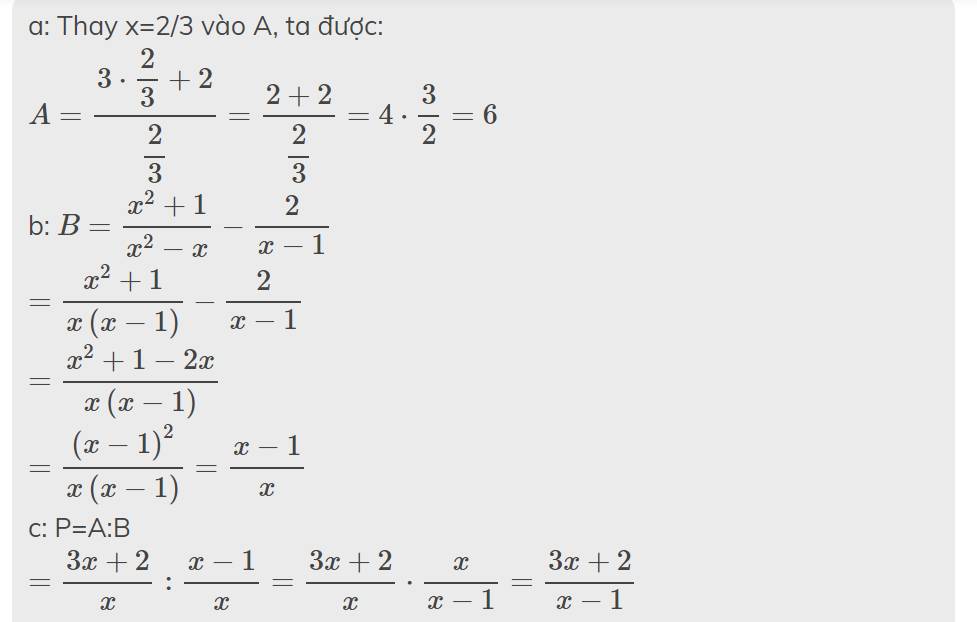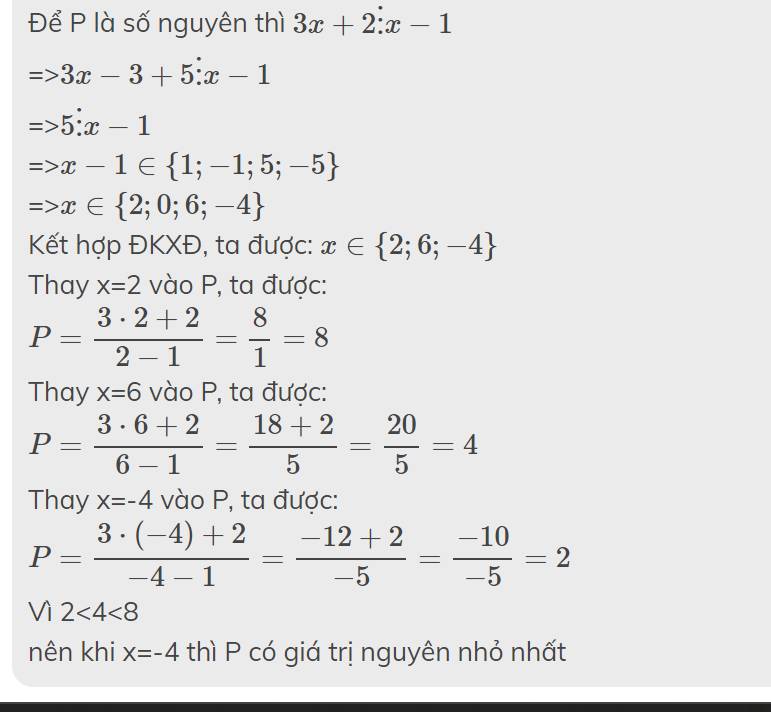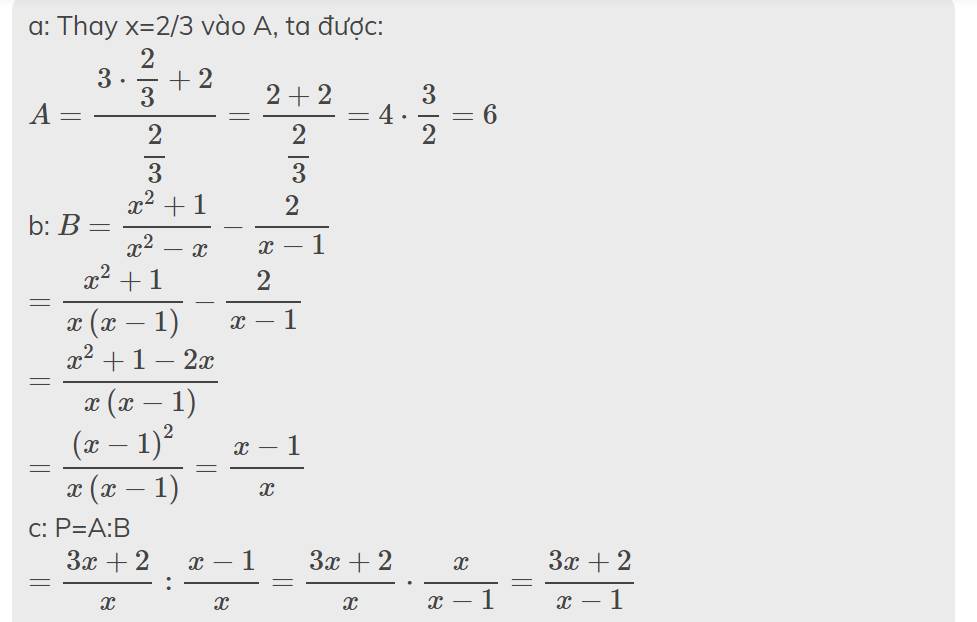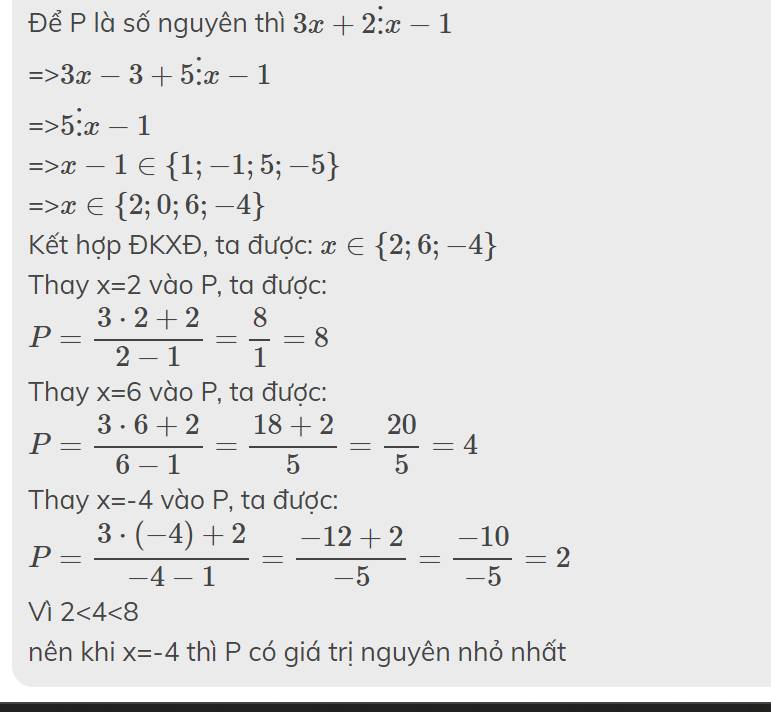
Hãy nhập câu hỏi của bạn vào đây, nếu là tài khoản VIP, bạn sẽ được ưu tiên trả lời.


a:
ĐKXĐ: x<>-1/2
Để \(\dfrac{2x^3+x^2+2x+2}{2x+1}\in Z\) thì
\(2x^3+x^2+2x+1+1⋮2x+1\)
=>\(2x+1\inƯ\left(1\right)\)
=>2x+1 thuộc {1;-1}
=>x thuộc {0;-1}
b:
ĐKXĐ: x<>1/3
\(\dfrac{3x^3-7x^2+11x-1}{3x-1}\in Z\)
=>3x^3-x^2-6x^2+2x+9x-3+2 chia hết cho 3x-1
=>2 chia hết cho 3x-1
=>3x-1 thuộc {1;-1;2;-2}
=>x thuộc {2/3;0;1;-1/3}
mà x nguyên
nên x thuộc {0;1}
c:
ĐKXĐ: x<>2
\(\dfrac{x^4-16}{x^4-4x^3+8x^2-16x+16}\in Z\)
=>\(\left(x^2-4\right)\left(x^2+4\right)⋮\left(x-2\right)^2\left(x^2+4\right)\)
=>\(x+2⋮x-2\)
=>x-2+4 chia hết cho x-2
=>4 chia hết cho x-2
=>x-2 thuộc {1;-1;2;-2;4;-4}
=>x thuộc {3;1;4;0;6;-2}


a: Để C là số nguyên thì \(3x^3+6x^2+3x+x^2+2x+1-2⋮x^2+2x+1\)
=>\(x^2+2x+1\in\left\{1;-1;2;-2\right\}\)
=>(x+1)^2=1 hoặc (x+1)^2=2
=>\(x\in\left\{0;-2;\sqrt{2}-1;-\sqrt{2}-1\right\}\)
b: Để D là số nguyên thì \(x^4+x^2+x^3+x-29⋮x^2+1\)
=>\(x^2+1\in\left\{1;-1;29;-29\right\}\)
=>x^2+1=1 hoặc x^2+1=29
=>\(x\in\left\{0;2\sqrt{7};-2\sqrt{7}\right\}\)

a: Thay x=2/3 vào A, ta được:
\(A=\dfrac{3\cdot\dfrac{2}{3}+2}{\dfrac{2}{3}}=\dfrac{2+2}{\dfrac{2}{3}}=4\cdot\dfrac{3}{2}=6\)
b: \(B=\dfrac{x^2+1}{x^2-x}-\dfrac{2}{x-1}\)
\(=\dfrac{x^2+1}{x\left(x-1\right)}-\dfrac{2}{x-1}\)
\(=\dfrac{x^2+1-2x}{x\left(x-1\right)}\)
\(=\dfrac{\left(x-1\right)^2}{x\left(x-1\right)}=\dfrac{x-1}{x}\)
c: P=A:B
\(=\dfrac{3x+2}{x}:\dfrac{x-1}{x}=\dfrac{3x+2}{x}\cdot\dfrac{x}{x-1}=\dfrac{3x+2}{x-1}\)
Để P là số nguyên thì \(3x+2⋮x-1\)
=>\(3x-3+5⋮x-1\)
=>\(5⋮x-1\)
=>\(x-1\in\left\{1;-1;5;-5\right\}\)
=>\(x\in\left\{2;0;6;-4\right\}\)
Kết hợp ĐKXĐ, ta được: \(x\in\left\{2;6;-4\right\}\)
Thay x=2 vào P, ta được:
\(P=\dfrac{3\cdot2+2}{2-1}=\dfrac{8}{1}=8\)
Thay x=6 vào P, ta được:
\(P=\dfrac{3\cdot6+2}{6-1}=\dfrac{18+2}{5}=\dfrac{20}{5}=4\)
Thay x=-4 vào P, ta được:
\(P=\dfrac{3\cdot\left(-4\right)+2}{-4-1}=\dfrac{-12+2}{-5}=\dfrac{-10}{-5}=2\)
Vì 2<4<8
nên khi x=-4 thì P có giá trị nguyên nhỏ nhất

Lời giải:
Bạn thay các giá trị $x$ trong đáp án thì thấy không có đáp án nào đúng.

a/
ĐKXĐ: \(x\ne\left\{-1;0;1\right\}\)
b.
\(A=\dfrac{x\left(x^2+2x+1\right)}{x\left(x^2-1\right)}=\dfrac{x\left(x+1\right)^2}{x\left(x+1\right)\left(x-1\right)}=\dfrac{x+1}{x-1}\)
c.
\(A=2\Rightarrow\dfrac{x+1}{x-1}=2\)
\(\Rightarrow x+1=2x-2\)
\(\Rightarrow x=3\) (thỏa mãn)
d.
\(A=\dfrac{x+1}{x-1}=\dfrac{x-1+2}{x-1}=1+\dfrac{2}{x-1}\)
\(A\) nguyên \(\Leftrightarrow\dfrac{2}{x-1}\) nguyên
\(\Rightarrow x-1=Ư\left(2\right)\)
\(\Rightarrow\left[{}\begin{matrix}x-1=-2\\x-1=-1\\x-1=1\\x-1=2\end{matrix}\right.\) \(\Rightarrow\left[{}\begin{matrix}x=-1\left(ktm\right)\\x=0\left(ktm\right)\\x=2\left(tm\right)\\x=3\left(tm\right)\end{matrix}\right.\)
Vậy \(x=\left\{2;3\right\}\) thì A nguyên

BÀI 1:
a) \(ĐKXĐ:\) \(x-3\)\(\ne\)\(0\)
\(\Leftrightarrow\)\(x\)\(\ne\)\(3\)
b) \(A=\frac{x^3-3x^2+4x-1}{x-3}\)
\(=\frac{\left(x^3-3x^2\right)+\left(4x-12\right)+11}{x-3}\)
\(=\frac{x^2\left(x-3\right)+4\left(x-3\right)+11}{x-3}\)
\(=x^2+4+\frac{11}{x-3}\)
Để \(A\)có giá trị nguyên thì \(\frac{11}{x-3}\)có giá trị nguyên
hay \(x-3\)\(\notinƯ\left(11\right)=\left\{\pm1;\pm11\right\}\)
Ta lập bảng sau
\(x-3\) \(-11\) \(-1\) \(1\) \(11\)
\(x\) \(-8\) \(2\) \(4\) \(14\)
Vậy....




\(A=\dfrac{x+2}{x^2-x+3}\Leftrightarrow Ax^2-Ax+3A=x+2\\ \Leftrightarrow Ax^2-x\left(A+1\right)+3A-2=0\\ \Leftrightarrow\Delta=\left(A+1\right)^2-4A\left(3A-2\right)\ge0\\ \Leftrightarrow-11A+10A+1\ge0\\ \Leftrightarrow-\dfrac{1}{11}\le A\le1\)
Mà \(A\in Z\Leftrightarrow A\in\left\{0;1\right\}\)
\(+)A=0\Leftrightarrow x+2=0\Leftrightarrow x=-2\\ +)A=1\Leftrightarrow x+2=x^2-x+3\Leftrightarrow x=1\)
Vậy \(x\in\left\{-2;1\right\}\Leftrightarrow A\in Z\)